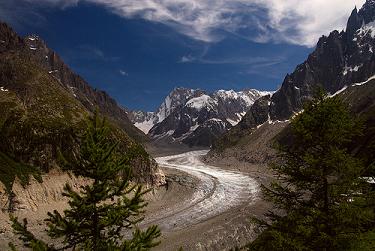It’s membership time. Cultivate Canada’s media. Support rabble.ca. Become a member.
The Intergovernmental Panel on Climate Change (IPCC) held its 35th session recently in Geneva, on the northern shore of Lac Leman. Across the water from the UN quadrant where the IPCC’s decision-making body met lies Mont Blanc.
At 4,800 metres Mont Blanc is the highest peak in the Alps. Like nearly all alpine glaciers, it is losing mass at a rapid rate. Light brown patches on its slopes point to where the ice recently lay and the extent of the mountain’s glacial retreat is obvious and worrisome. It is disappearing as fast as the multi-year sea ice in the Arctic.
Among other things, the IPCC discussed its 2014 Fifth Assessment Report, which will examine the state of the global climate. Produced every seven years, the IPCC reports are the product of careful consideration and much negotiation by the government representatives in the room. The tone of the session is very different from the frenetic two-week marathon of the United Nations Framework Convention Climate Change negotiations that take place very December.
The IPCC meeting came just after the news broke that greenhouse gas levels have reached 400 parts per million in the Arctic for the first time.
This is an important threshold. It is more than 800,000 years since there was this much CO2 in the atmosphere. The 2007 IPCC assessment stated that to avoid dangerous changes to our climate, global greenhouse gas levels have to be stabilized at 350 ppm. To get there, a global commitment is needed to reduce CO2 emissions by 40 per cent by 2020 over 1990 levels. There was supposed to be a new binding climate change treaty by 2009. Instead, the negotiations nearly collapsed that year in Copenhagen and since then governments have produced only fine statements, a framework for further negotiations and reduced targets.
The readings in the Arctic are important because the region is an indicator of changes to come. What happens in the oceans and atmosphere of the Arctic affects the rest of the planet. The rapidity of change, and the increase in temperatures in many parts of the region, presage what is to come in the rest of the planet if we don’t get our emissions under control. (As a point of reference, CO2 levels were approximately 275 ppm before the industrial revolution.)
Since 2009, Canada, the United States and other countries have latched on to unscientific targets that make good sound bites. Canada and the U.S. committed to reduce their emissions by 17 per cent over 2005 levels. Just to be sure no one was confused about the real commitment of the Harper government, Canada withdrew from the Kyoto Protocol, making it the only country in the world to officially abrogate this binding international agreement.
This spring the government slashed environmental protection legislation and demonized environmental groups and anyone who dared to criticize its no-hold-barred push for “responsible resource development.” The message was clear: You are either for the economy or the environment. You can’t be both.
Any hope of a sensible climate change policy based on science and fact rather than ideology and rhetoric has all but vanished off the government’s radar. As the National Roundtable on the Economy and Environment (NRTEE) reported recently, “Canada will not achieve its 2020 GHG emission reductions target unless significant new, additional measures are taken. More will have to be done. No other conclusion is possible.”
Of course, the Harper government doesn’t need this kind of advice. After 20 years, the NRTEE, a body established by Conservative Prime Minister Brian Mulroney, has had its funding eliminated. In the words of Foreign Affairs Minister John Baird, why should the government continue to pay for advice it doesn’t want to hear?
You don’t have to go very far to see what the consequences of this kind of position. For a government that claims to have Arctic interests at heart, the policies of the Harper government are relegating a vast portion of the region to irreversible change.
On Canada Day, while Harper cabinet ministers fanned across the country to wave flags, flip burgers, and deliver the uniform lines about jobs, prosperity and growth fashioned in the Prime Minister’s office, an updated graphic appeared on the website of the National Snow and Ice Data Centre in Boulder, Colorado. The centre produces daily updates of real-time satellite tracking of the state of Arctic sea ice. On July 1, the graphic showed a continued drop in multi-year sea ice that indicates that 2012 could beat previous record lows from 2007.
Humans are causing this problem. Yes, the climate has cycles and natural variation. But at no time in planetary history has this much warming occurred in such a short time. It’s not caused by sunspots or volcanoes and it’s above the levels of the natural cycle, all of which skeptics and their paymasters like to point to. And even if we weren’t causing it, we would have to take precautionary measures to ensure that we can adapt to it.
What we know as human civilization has developed in the clement period since the last ice age — a period of about 10,000 years. One hundred centuries may seem like a long time to us but it is a blink of the geological eye. While the planet will eventually rebalance itself — in thousands of years — we need to ask ourselves if what we know as human society will be around to see it.
Since we can’t answer this question with certainty, we need to think deeply about where our political leaders are taking us, in this country and elsewhere.
There is no chance of a healthy economy without a livable environment.
John Crump is a CCPA research associate and an expert on Arctic and global environmental issues. This article was first posted on Behind the Numbers.



